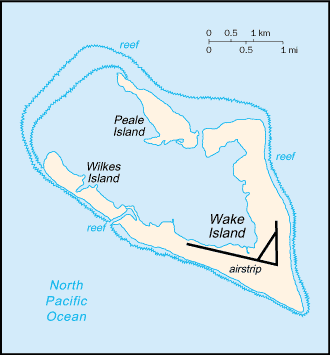- Wake Island
-
 Introduction ::Wake IslandBackground:The US annexed Wake Island in 1899 for a cable station. An important air and naval base was constructed in 1940-41. In December 1941, the island was captured by the Japanese and held until the end of World War II. In subsequent years, Wake was developed as a stopover and refueling site for military and commercial aircraft transiting the Pacific. Since 1974, the island's airstrip has been used by the US military, as well as for emergency landings. Operations on the island were suspended and all personnel evacuated in 2006 with the approach of super typhoon IOKE (category 5), but resultant damage was comparatively minor. A US Air Force repair team restored full capability to the airfield and facilities, and the island remains a vital strategic link in the Pacific region.Geography ::Wake IslandLocation:Oceania, atoll in the North Pacific Ocean, about two-thirds of the way from Hawaii to the Northern Mariana IslandsGeographic coordinates:19 17 N, 166 39 EArea:total: 6.5 sq kmcountry comparison to the world: 244land: 6.5 sq kmwater: 0 sq kmArea - comparative:about 11 times the size of The Mall in Washington, DCLand boundaries:0 kmCoastline:19.3 kmMaritime claims:territorial sea: 12 nmexclusive economic zone: 200 nmClimate:tropicalTerrain:atoll of three low coral islands, Peale, Wake, and Wilkes, built up on an underwater volcano; central lagoon is former crater, islands are part of the rimElevation extremes:lowest point: Pacific Ocean 0 mhighest point: unnamed location 6 mNatural resources:noneLand use:arable land: 0%permanent crops: 0%other: 100% (2011)Irrigated land:0 sq km (2011)Natural hazards:occasional typhoonsEnvironment - current issues:NAGeography - note:strategic location in the North Pacific Ocean; emergency landing location for transpacific flightsPeople and Society ::Wake IslandPopulation:no indigenous inhabitantsnote: approximately 150 military personnel and civilian contractors maintain and operate the airfield and communications facilities (2009)Government ::Wake IslandCountry name:conventional long form: noneconventional short form: Wake IslandDependency status:unorganized, unincorporated territory of the US; administered from Washington, DC by the Department of the Interior; activities in the atoll are currently conducted by the US Air ForceLegal system:US common lawFlag description:the flag of the US is usedEconomy ::Wake IslandEconomy - overview:Economic activity is limited to providing services to military personnel and contractors located on the island. All food and manufactured goods must be imported.Communications ::Wake IslandTelephone system:general assessment: satellite communications; 2 Defense Switched Network circuits off the Overseas Telephone System (OTS); located in the Hawaii area code - 808Broadcast media:American Armed Forces Radio and Television Service (AFRTS) provides satellite radio/TV broadcasts (2009)Transportation ::Wake IslandAirports:1 (2013)country comparison to the world: 211Airports - with paved runways:total: 12,438 to 3,047 m: 1 (2013)Ports and terminals:none; two offshore anchorages for large shipsTransportation - note:there are no commercial or civilian flights to and from Wake Island, except in direct support of island missions; emergency landing is availableMilitary ::Wake IslandMilitary - note:defense is the responsibility of the US; the US Air Force is responsible for overall administration and operation of the island facilities; the launch support facility is administered by the US Missile Defense Agency (MDA)Transnational Issues ::Wake IslandDisputes - international:claimed by Marshall Islands"
Introduction ::Wake IslandBackground:The US annexed Wake Island in 1899 for a cable station. An important air and naval base was constructed in 1940-41. In December 1941, the island was captured by the Japanese and held until the end of World War II. In subsequent years, Wake was developed as a stopover and refueling site for military and commercial aircraft transiting the Pacific. Since 1974, the island's airstrip has been used by the US military, as well as for emergency landings. Operations on the island were suspended and all personnel evacuated in 2006 with the approach of super typhoon IOKE (category 5), but resultant damage was comparatively minor. A US Air Force repair team restored full capability to the airfield and facilities, and the island remains a vital strategic link in the Pacific region.Geography ::Wake IslandLocation:Oceania, atoll in the North Pacific Ocean, about two-thirds of the way from Hawaii to the Northern Mariana IslandsGeographic coordinates:19 17 N, 166 39 EArea:total: 6.5 sq kmcountry comparison to the world: 244land: 6.5 sq kmwater: 0 sq kmArea - comparative:about 11 times the size of The Mall in Washington, DCLand boundaries:0 kmCoastline:19.3 kmMaritime claims:territorial sea: 12 nmexclusive economic zone: 200 nmClimate:tropicalTerrain:atoll of three low coral islands, Peale, Wake, and Wilkes, built up on an underwater volcano; central lagoon is former crater, islands are part of the rimElevation extremes:lowest point: Pacific Ocean 0 mhighest point: unnamed location 6 mNatural resources:noneLand use:arable land: 0%permanent crops: 0%other: 100% (2011)Irrigated land:0 sq km (2011)Natural hazards:occasional typhoonsEnvironment - current issues:NAGeography - note:strategic location in the North Pacific Ocean; emergency landing location for transpacific flightsPeople and Society ::Wake IslandPopulation:no indigenous inhabitantsnote: approximately 150 military personnel and civilian contractors maintain and operate the airfield and communications facilities (2009)Government ::Wake IslandCountry name:conventional long form: noneconventional short form: Wake IslandDependency status:unorganized, unincorporated territory of the US; administered from Washington, DC by the Department of the Interior; activities in the atoll are currently conducted by the US Air ForceLegal system:US common lawFlag description:the flag of the US is usedEconomy ::Wake IslandEconomy - overview:Economic activity is limited to providing services to military personnel and contractors located on the island. All food and manufactured goods must be imported.Communications ::Wake IslandTelephone system:general assessment: satellite communications; 2 Defense Switched Network circuits off the Overseas Telephone System (OTS); located in the Hawaii area code - 808Broadcast media:American Armed Forces Radio and Television Service (AFRTS) provides satellite radio/TV broadcasts (2009)Transportation ::Wake IslandAirports:1 (2013)country comparison to the world: 211Airports - with paved runways:total: 12,438 to 3,047 m: 1 (2013)Ports and terminals:none; two offshore anchorages for large shipsTransportation - note:there are no commercial or civilian flights to and from Wake Island, except in direct support of island missions; emergency landing is availableMilitary ::Wake IslandMilitary - note:defense is the responsibility of the US; the US Air Force is responsible for overall administration and operation of the island facilities; the launch support facility is administered by the US Missile Defense Agency (MDA)Transnational Issues ::Wake IslandDisputes - international:claimed by Marshall Islands"
The World Factbook. 2014.
